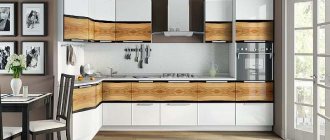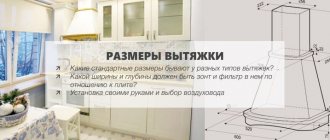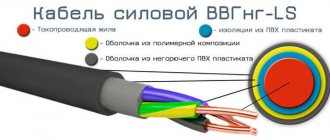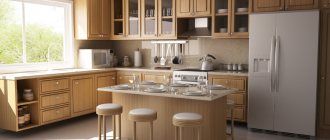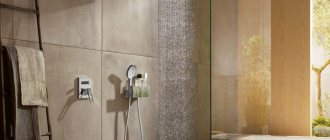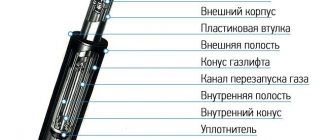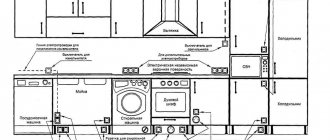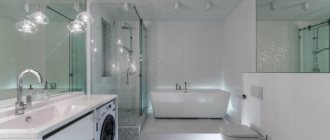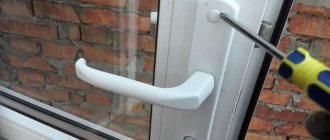A kitchen hood is used to clean the air collected above the stove from particles of dust and grease, processed gas, and soot. And the height of the hood above a gas stove and other types of cooking surfaces affects the quality of operation of the device and its efficiency.
How to correctly calculate the height between the hood and the stove? What affects height? Are there any standards? And what happens if they are not followed? We will consider all these issues in detail in our article, focusing on the types of hoods for the kitchen and the rules for carrying out calculations and measurements.
Basic functions of a kitchen hood
The main function of the hood is to remove or filter polluted air. Like a vacuum cleaner, the hood sucks in air and directs it into a ventilation shaft or passes it through filters that trap unwanted particles.
The products released during the combustion of natural gas are dangerous to human health. Therefore, removing these substances is a key task of the hood.
The device provides a flow of fresh air into the room and maintains a normal atmosphere in it. An equally important function of this device is to get rid of carcinogenic substances.
It will also prevent the spread of grease and soot throughout the kitchen, saving the housewife time and effort and saving her from labor-intensive daily cleaning of surfaces.
Ventilation requirements
A properly functioning ventilation duct is essential for proper operation of the appliance. This only applies to recirculating hoods.
Recirculation systems do not require air exhaust, so this rule does not apply to them.
Without a properly organized ventilation system, problems such as
- Pressure difference in air ducts;
- poor air conductivity;
- air intake from the street.
This places additional stress on the internal engine. To eliminate these problems, the exhaust device is set to a higher operating speed. Additional load causes increased noise, wear of unit parts and energy consumption.
In apartment buildings, the exhaust system is designed by the developer and implemented in accordance with current norms and standards. It is connected to the general installation using a corrugated pipe.
Important: Keep connections short and minimize the number of elbows. Any obstructions impede the air flow and create additional stress on the engine. In a private house, ventilation is designed before construction begins in accordance with approved standards and rules, national standards
If you do not have practical experience, it is better to entrust the work to professional builders
In a detached house, ventilation must be designed before construction begins in accordance with approved codes and regulations and national standards. If you do not have experience, it is recommended that a professional builder carry out the work.
The height of the kitchen hood above the gas stove: standards according to GOST, norms
Gas is a source of open flame. Therefore, the equipment is installed above the hob at a certain distance. Only in this way can the efficient operation of the device be guaranteed. According to accepted standards, the distance from the hob depends on the type of hood:
- Simple ventilation is corner ventilation, recessed ventilation, dome ventilation and flat ventilation. Their peculiarity is that the filters are located parallel to the hob. In this case, the minimum installation height is 75 cm, and the maximum is 85.
- Inclined – the filter is installed at an angle to the hob. The recommended distance is 55 to 65 cm.
Important
For more comfortable operation of the hob, the height can be adjusted depending on the power of the device and technical characteristics. The height of the person who will cook is also taken into account.
To find out at what height the hood should be hung, place the beginning of the measuring tape on the burner and measure the distance according to the specifications. You should also consider the distance to the outlet.
Conclusions and useful video on the topic
From the video you can find out at what height you should install the hood and why it is important to adhere to these standards:
Calculating the required height of the hood above the surface of the slab is important for each case. Use the tips given in the article, do the calculations and then there will always be fresh and clean air in your kitchen .
Do you still have questions after reading our publication? Ask them in the comments block - our experts will try to help you.
Or maybe you have comments, additions, or have you noticed inaccuracies in the material presented above? Please write to us about this below the article.
Types of kitchen hoods for installation
Devices can be divided into four types depending on the method of their installation. The first one is mounted on the wall. The panels are attached to the wall directly above the hob, taking into account the distance from the floor surface to the lower level of the appliance.
The second type is a corner hood. The principle of their installation is clear from the name itself. These models are not widely used due to low demand. The same applies to appliances that are installed in the countertop. Other disadvantages of built-in hoods are high cost and limited power.
The fourth option is the island version. They are installed on the ceiling directly above the hob. The height of the gas hob does not matter - the distance can be adjusted by changing the size of the ventilation pipe. These models often become a design element.
Types and peculiarities of exhaust devices
Principle of operation
All products currently on the market can be divided into two large classes based on their operating principle: circulation and exhaust.
Circulating
Circulation units provide filtration of kitchen air through a built-in system of multi-stage filters. After this, the purified air is returned to the kitchen.
As a rule, they consist of a separator filter that traps large particles and a carbon filter that absorbs odors.
The polluted air above the stove is drawn into the exhaust hood by a fan, passes through the filter system and ends up back in the room.
The efficiency and productivity of such systems is low. They are recommended to be used only in cases where it is not possible to connect the hood to the ventilation system.
Exhaust
Exhaust structures ensure the removal of polluted air from the premises through the ventilation duct of the building.
In devices of this type, mechanical grease filters must be used to prevent “clogging” of the ventilation duct.
Before choosing a model, it is necessary to calculate the required power of the exhaust hood.
As a rule, many modern models are universal. They can operate in both circulation and exhaust mode, depending on the connection method.
Design
Based on the type of design, hoods are divided into the following types.
- With a flat surface.
- Domed.
- Inclined.
- Built-in.
Flat surface devices
The simplest and most cost-effective type of exhaust devices, characterized by compact size and low price.
These models are able to work most efficiently autonomously in circulation mode, thanks to the filters built inside.
The disadvantages of these devices include the need for regular cleaning and replacement of filter elements
. In most cases, technology is not aesthetically attractive enough. These shortcomings are partly compensated by the relatively low cost of the product.
Dome
Another type of device that has become widespread in our kitchens.
The main operating mode of devices of this type is exhaust. They capture hot air rising upward, which is saturated with water vapor and fat particles. And then it is removed from the room through the ventilation duct.
The effective operation of these models depends on proper installation. In this case, it is provided even in passive mode, without turning on the built-in fan.
Some models of exhaust hoods provide the possibility of installing carbon filters to ensure operation in circulation mode with reduced efficiency.
Oblique
Devices with an inclined surface are a type of dome exhaust devices.
They are considered the most aesthetically perfect and modern. These devices combine an attractive appearance, excellent workplace ergonomics and high efficiency.
The main disadvantage of these devices is the relatively high cost.
Built-in
The main difference between these models and those listed above is that the structure itself and the air ducts are hidden from view in the wall cabinet.
Types of kitchen hoods
Hoods are used for the forced removal of combustion products, various pollutants (nitrogen oxide, carbon dioxide, various carcinogens) and unpleasant odors that appear in the air during cooking. This system works like a vacuum cleaner.
A standard kitchen hood consists of the following components: housing, electric motor, air intake, ventilation system and grease (and sometimes carbon) filters.
An island hood is ideal for large kitchens and wide hobs. In this situation, the height of the cook must be taken into account.
Depending on the method of removing exhaust air, these devices are either circulating or flow-through. In the first case, the air is cleaned and filtered, and then supplied again to the room; in the second case, the air is discharged outside. Circulation units are suitable if there is no ventilation in the house.
Recently, hoods have begun to appear that combine both air purification technologies.
There are several types of hoods in terms of how they are installed. Ceiling mounted, they are mounted on the ceiling. Corner hoods can be installed in the corner of the kitchen. These models are suitable for small kitchens.
As for installation, the built-in hood can be easily hidden in a closet. Dome models are wall mounted. They are a great addition to the interior, but are often large in size.
The built-in hood is suitable for kitchens of any size. It is installed in a special cabinet. Furniture is made to order or it is possible to re-equip existing furniture.
At what height should the hood be installed above the gas stove?
Recommendations on the height of hoods and kitchen hoods are given not only by appliance manufacturers, but also by specialists who install them. People are faced with an important question: At what height should a hood be hung above a gas stove? After all, they are common in many apartments and houses, and the substances released during cooking are higher than those of other types of stoves.
Manufacturers include documentation with each hood, which indicates not only the distance characteristics, but also other installation recommendations. For example, Saturn strongly recommends installing hoods 75 cm higher than a gas stove. Bosch, on the other hand, recommends a height of 55 cm (distance reduced for greater efficiency).
Only three criteria determine the distance (fire hazard, ease of cooking and appliance efficiency). Having exact numbers and data for the hood, you can independently calculate the installation height.
It is also important to consider at what height to install the hood above the electric stove. It would seem that an electric hob emits less unpleasant objects during operation than a gas one, but it is important not to exaggerate by reducing the distance.
Distance between hoods for gas and electric hobs
Horizontal hoods can be installed above electric hobs at a height of 65 cm. This is the optimal distance that does not compromise personal comfort, allowing the hood to reach its full potential without compromising performance.
It is best to install inclined hoods above an electric stove at a distance of 40-50 cm. However, it should be borne in mind that for tall people this figure will mean discomfort near the hob.
Standards
There are some rules and recommendations related to the safety and efficiency of the hood. On the one hand, it should absorb odors as much as possible, and on the other hand, the distance between it and the stove should not interfere with the housewife’s work and create a fire hazard. We invite you to look at the table for installation standards for hoods.
| Stove type | Approximate height, cm |
| Gas (direct exhaust) | 75-85 |
| Gas (inclined) | 55-65 (bottom) |
| Electric (direct) | 65-75 |
| Electric (inclined) | 35-45 (lower part) |
The height range is not random. When choosing the exact level, you will rely on three factors:
- extraction power;
- design, room configuration;
- the height of a person who most often stands at the stove.
At your own discretion, you can slightly increase the installation height, but you cannot reduce it.
Firstly, it will make it difficult to work at the stove; the cook will constantly hit his head, and it will be inconvenient for him to look into the pots. Secondly, the hood can become very hot, and in some cases there is a risk of soot deposited on the filter catching fire.
The instructions usually indicate what the distance from the stove to the hood should be, which greatly simplifies the choice. In addition, if a specialist deals with this issue, he will advise you on how best to install the entire system, including the location of the outlet and air duct.
When choosing a hood, it is necessary to take into account that in most cases manufacturers indicate in the technical data sheet the ideal parameters at which free air flow passes through the blades. In reality, the operating efficiency will be less due to the resistance of the filters (for recirculation units) or the insufficient cross-section of the ventilation ducts (in the case of installing exhaust-type systems). In the first case, it will be enough to calculate the productivity using the classical formula P=Qx12, where Q is the volume of the kitchen in cubic meters, and the number 12 corresponds to the recommended air exchange per hour and increase the resulting value by 30-40%.
If a household appliance operates in exhaust mode, then calculating its performance based on the volume of the room will not be entirely correct. The fact is that no matter how large the kitchen is, the hood will only allow a certain amount of air through it - it all depends on the pressure created, as well as the cross-section and configuration of the ventilation duct. According to the existing SNiP, exhaust lines have a cross-section of no more than 150x150 mm, which means that if you need to remove 500 cubic meters of air, the exhaust unit must create a pressure of at least 8 Pa. If we take into account the complex configuration of ventilation shafts, as well as obstacles in the form of broken bricks that fell during construction, protruding mortar build-ups and thresholds at the junction of reinforced concrete blocks, then the channel capacity will decrease by more than 10-20%.
You can calculate the parameters of the hood using special formulas (the method can easily be found on the Internet), or use a graph of the dependence of productivity on the pressure of the unit and the cross-section of the exhaust duct. One such diagram is shown below.
When choosing a hood based on performance, you should rely on the maximum pressure indicators and the cross-section of the ventilation duct
What does distance affect?
It’s not for nothing that manufacturers pay attention to the height of the kitchen hood. If the pattern is followed, the device will perform its tasks effectively and it will be easier for people to use its capabilities.
A kitchen hood installed below the recommended height can have many unpleasant consequences. A tall person will find it uncomfortable to cook and will bang his head on the cabinet. One of the main risks is the possibility of combustion of soot that settles on the filter over a long period of time. In addition, such a hood will be inconvenient to maintain (replacing or cleaning the filter).
In addition, the lower the hood is positioned above the stove, the smaller the radius within which it can absorb water vapor and other emissions. Therefore, it is important to follow the manufacturer's recommendations.
If the hood is installed high, the efficiency of the device will decrease several times. To cope with the load, you will have to work at maximum power, which will lead to high energy consumption and rapid destruction of the exhaust system.
It should be noted that there are no national standards in this regard, but manufacturers always indicate in the technical documentation of the hood the permissible height of the device above the stove.
There are factors that directly affect the calculation of the distance from the hood to the stove. These include:
- Man's height;
- Kitchen height;
- Size and type of hob;
- Kitchen layout;
- Extractor type and power.
It should also be taken into account that there are standards for electrical wiring and electrical installations. By following these tips and correctly installing the hood above the hob, you can use the full performance potential of the appliance and ensure its comfortable operation.
Installation of air ducts and power supply connections
Hood with corrugated air duct
When installing the air duct, we advise you to pay attention to the following important details:
- outlet channels for a wall-mounted kitchen hood are made up of relatively short and straight sections with a minimum number of bends, the radius of which should be chosen as large as possible;
- when using corrugated hoses as a discharge channel, their bending angle should not be less than 90 degrees;
- It is also not recommended to narrow the outlet section of the air duct, which can lead to increased noise;
- The hatch of the ventilation shaft to which the air duct is connected must be completely cleaned of all contaminants accumulated during its operation.
The operation of the exhaust mechanism requires an electrical network, the supply of which must be provided in advance. As a rule, products of this class are equipped with a cord with a plug, for connecting which a specially equipped socket with a grounding contact must be used.
Important! To avoid heating, such an outlet should not be located above the area where the hood is located.
Device installation rules
An exhaust system that filters and recirculates the air is easy to install. You can install it yourself over an electric stove.
- At the installation height above the hob, draw a horizontal line - the distance between the gas hob and the hood.
- A vertical line is drawn in the center of the hob on the wall. The standard states that the hood must be installed exactly above the hob.
- We attach the template from the packaging to the line and mark 4 points - the locations of the mounting screws. Depending on the model, the distance between them is standardized and is 200×200 or 200×100 mm.
- Drill holes, insert dowels and screw in screws.
- Hang the structure without the filter mesh and housing on the wall.
- Install the remaining components of the mechanism.
Spacious kitchen with an electric stove
If you purchase a hood with a ventilation duct or chimney, install the ventilation unit itself on the wall in the same way as a model with a circulation air purification system. The air duct must be installed taking into account the minimum distance between the hood and the gas or electric stove. To ensure proper ventilation, it is worth calling in specialists to prevent the recirculation effect, i.e. returning air masses from ventilation ducts back to the air duct.
The basic requirements for air ducts are as follows:
- The cross-section of the air duct is designed for the passage of air masses through it at maximum unit performance;
- the safety factor is included in the formula for a specific design;
- the optimal distance from the external wall or ventilation duct should not exceed 5 m;
- no more than 3 bends in the air duct;
- Pipes with different cross sections are not suitable for the ventilation system;
- All bends must be smooth, with radii.
When planning the location of household appliances in the kitchen, the stove should be placed closer to the outer wall or opposite the ventilation ducts in the home.
Kitchen with a gas stove in a country house
The socket must be grounded and located at a distance of 25 cm from the hood body. The safest solution is to install a switch that will allow you to turn off the device instantly.
Calculation of the minimum required exhaust power
Before purchasing a new device for air purification in the kitchen, you should make some measurements and calculations in order to know exactly what power equipment will be able to efficiently purify the air in the kitchen.
Before purchasing a kitchen hood, it is necessary to accurately determine the volume of air in the ventilated room. Then make the calculation yourself. You can contact the seller with these measurements. It will determine the performance of the equipment. The minimum required power is determined by the formula:
Pb = Vk × 12 × 1.3 = (a × b × h) × 12 × 1.3
Where:
- Vk = (a × b × h) – kitchen volume;
- The air must be completely changed 12 times in 1 hour;
- 1.3 – actual power coefficient, it takes into account power losses when air passes through ventilation holes, filters and pipeline bends;
- Pb – design hood power.
All necessary measurements and power calculations can be made independently. It is enough to determine the length and width of the kitchen, as well as its height, using a tape measure. The numbers are written in meters. Then calculations are made using a simple calculator. By multiplying three numbers, you get the volume in cubic meters (m3). When multiplied by other coefficients, the resulting power is m3/hour.
Scheme and drawing
Model performance does not always match estimates exactly. The nearest higher value should be selected. A less powerful device costs less. But it will constantly work at maximum load, as a result of which it can quickly fail. There is also a possibility that the air will not be completely purified, and then odors will penetrate into the rooms.
Equipment with air exhaust into ventilation usually has high performance. It can be installed above an electric stove above the standard size. As a result of powerful exhaust ventilation, the kitchen and even living rooms will be completely cleaned not only from steam and grease.
Ventilation with exhaust to the outside removes moisture, carbon dioxide, and unpleasant odors from the apartment. The peculiarity of exhaust ventilation is that for its normal implementation it is necessary to ensure access of air from outside into the apartment.
Accounting for distances from the slab according to standards
You cannot install powerful equipment above a gas stove and hang it at a minimum distance from the heating elements. A close hole with a large air flow can blow out the burner flame.
Important rules for installing a hood
If you are going to install the hood yourself, check the installation conditions first. In particular, this applies to the rules and requirements for the height of the hood above the gas burner:
- For optimal performance, the width of the hood and the size of the hob should always be the same or slightly larger. The main requirement is that it should not be narrower than the hob.
- Typically, the distance between the hood and the hob depends on the type of hob recommended in the operating instructions.
- The socket to which the appliance is connected should be located as far as possible from the hob. It's a good idea to place it above a kitchen cabinet or hide it behind cabinet doors. Wires should be located away from sources of ignition.
- There should not be many bends and turns in the air duct itself and at the junction of the hood with the air duct. Otherwise, the air will come out with difficulty and excessive noise, as it encounters many obstacles.
- To avoid the risk of fire, observe the height of the hood above the gas hob as specified in the appliance's instruction manual. There are no general recommendations for the distance between the gas stove and the hood in the kitchen, but they can be obtained from each manufacturer. These can be found in the user manual. When determining the height of the hood above a gas stove, it is recommended to adhere to these recommendations.
- If there is no vent, choose the circulation option. It's much easier to install.
Homemade plasterboard hood
Special attention should be paid to a self-made structure made from plasterboard sheets. In this case, there is no need to buy rather expensive parts. And the hood itself from the manufacturer has a high cost
And the hood itself from the manufacturer has a high cost.
There is one more advantage of such designs: they can be made stylish, exclusive, and fit perfectly into the interior.
Materials and tools
You must first make a sketch and calculate the surface area for purchasing drywall. To do this, measure the location for installing the hood, draw it, and then draw up a sketch of the planned structure on paper.
The width of the home-made structure is taken equal to or slightly larger than the corresponding parameter of the slab. The height is determined constructively, depending on the location of the kitchen ventilation duct and the overall design solution.
The surface area is calculated as the sum of the products of the dimensions of each face. The quantity of purchased material should be slightly more than calculated. Additionally, you need to purchase screws and metal profiles.
In addition, putty and primer are purchased for finishing surfaces.
Tools needed for work:
- Hammer.
- Screwdriver.
- Roulette.
- Level.
- Stationery knife.
- Putty knife.
- Roller.
Step-by-step instructions for making a plasterboard hood
When all the preparatory work is completed, you can proceed directly to the process:
- Use a pencil to mark the places where the profiles are attached according to the sketch on the wall. Consider the standard height of the hood above the stove.
- Then install and screw the main (starting) profile onto the wall (and, if necessary, onto the ceiling). First you need to drill holes and hammer in strong dowels or anchors.
- Next, attach the vertical elements to the main profile with self-tapping screws.
- Attach the starting profile and cross members to the bottom. The result should be the frame of the air duct box.
- Next, make the cone of the hood itself. To do this, attach profiles that form stiffeners to the bottom of the box frame. Fix them horizontally at the bottom, observing the dimensions according to the sketch. To do this, also use self-tapping screws.
- At this stage, you can, if desired, install a fan to force air out, but even if you do not do this, the structure will still collect air flows from the stove well.
- Cut the drywall into pieces of the required size and screw them to the frame.
- All seams must be thoroughly puttied.
- The resulting hood must be coated with a primer.
This product provides natural ventilation of vapors from the stove.
All that remains is to decorate the hood.
Manufacturing of housing from various materials
In addition to drywall, other materials can be used to make hoods. For example, plywood or plastic panels. It all depends on the skills and capabilities of the owner.
The same plywood is easier to attach to profiles. It does not crumble and does not stain your hands. It does not need to be primed or puttied. And when finishing it, you can simply cover it with wallpaper.
Profiles for it, however, need stronger ones. It is better to use metal corners with a steel thickness of 1.5 - 2 mm. You can take stainless steel. The process of making a housing for a hood is the same as when using drywall.
Decorative finishing of the hood
The decorative coating of the plasterboard surface can be different.
Usually, after priming, water-based paint is applied to match the color of the kitchen unit or wall. In this case, the design is supplemented with moldings or foam baseboards, and sometimes with decorative wooden elements.
Wallpapering or even facing with ceramic tiles is possible. Drywall is such a versatile material that it can be used for any external treatment.
How to determine the mounting height of the hood
To determine the ideal installation height for the hood, it is often enough to refer to the hood manufacturer's instructions. There is usually no fixed distance specified, but rather a range within which the hood should be located.
It is necessary to take into account such important facts as the height of the housewife and the interior of the kitchen. But even if the instructions are lost, there is another option. There are standards that allow you to determine the height at which the hood should be located above the hob or stove.
It is necessary to take into account the type of hob, each type of hob has its own height characteristics. Recommended height for hood:
- On a gas burner it is placed at a height of 75-85 cm,
- Above electric stoves, 65-75 cm.
If you choose a model with a sloped surface, the distance from its bottom to the hob should be about 55-65 cm for gas hobs and about 35-45 cm for electric hobs.
The height may vary, but only within the specified 10 cm and depending on the power of the model and its technical characteristics. These restrictions cannot be ignored, since not only the quality of the device, but also operational safety and fire protection depend on them.
Criteria and rules for choosing a hood
When choosing a hood, be sure to pay attention not only to the appearance of the device, but also to such significant characteristics as its size, power, and noise level. The type of control is also important, additional “bonuses” from the manufacturer are added useful functions.
Size
The size of the hood must correspond to the dimensions of the hob and in no case should the device be smaller. The suction plane must cover the entire surface of the plate. Only in this case can the device operate efficiently. If you hang a hood 50 cm above a stove with a width of 60 cm or more, you should not expect a good result. The device will not cope with the removal of odors and grease, and the money will be wasted.
Power
The performance of the hood, its power, depends on the power of the fans built into it. More often, systems are equipped with one or two air exhaust devices. Fans can operate at different speeds. Typically, hoods are equipped with two or four modes. Productivity is determined by the amount of air purified per hour. In different models, this figure varies between 200 -700 m3/h. There are expensive hoods, the power of which reaches 1300 m3/h. According to GOST 26813-99, the capacity of the ventilation unit above the hob should not be less than 200 m3/h.
High power makes it possible to quickly and effectively remove grease and unpleasant odors. In emergency situations - food has burned, milk has run out - this ability will be very useful. But there is no point in forcing the hood to constantly work in this mode. At maximum speed, the device makes a lot of noise, which only gets in the way. Therefore, fans with medium power are quite sufficient for normal cooking or heating of food.
You should also focus on the dimensions of the room. The amount of air that needs to be renewed 10 to 12 times per hour depends on them. To calculate this indicator, you need to calculate the volume of the kitchen, subtract from it the volume of the furniture present and multiply by 10. The resulting value will correspond to the optimal power level of the hood.
Control type
Manufacturers offer a choice of equipment with three control panel options.
Exist:
- touch panels – the device is incredibly comfortable to use. Simply touch your finger to the intended area and the device will begin performing the task. The LED indicates that work has started;
- panels with slider-type controls - in order to turn on the hood and adjust the power level, you need to move the slider;
- panels equipped with buttons - each button is responsible for a particular task.
Additional functions
The functionality of the hood can be expanded. Additional features make it easier to manage the equipment and make it more comfortable for the user. Of course, expanding the “arsenal” of capabilities cannot but affect the final price of the device.
There are several types of additional functions:
- Responsible for the convenient use of the device are a remote control, multi-stage power regulators, a touch panel, and a display showing the operating mode. All these features make operating the hood simple and enjoyable.
- Additional “bonuses” not involved in air removal - built-in TV, integrated recipe book, computer, Internet access. The built-in timer will allow you not to think about the need to turn off the hood yourself after a certain time. Faber Imago even provides the ability to keep an eye on children in another room using video telephony.
- Parts for automating the operation of the device - the presence of sensors that detect the presence of smoke and odors, a programming function - to set a shutdown delay or automatically stop operation after intensive removal of fumes and odors.
- Illuminate countertops and stoves with built-in halogen or LED lamps. Access to lighting control makes it possible to use it as a decorative component of the interior.
- Continuous operation mode according to a given program - allows you to constantly maintain a comfortable microclimate in the room.
What are the dangers of incorrect height?
If the height of the hood above an electric or gas stove is chosen incorrectly, the user may face unpleasant consequences. In particular, if the hood is located too low, the following problems may occur:
- Constant overheating of the device;
- possible ignition of deposits accumulated on the filter;
- Difficulties in servicing the appliance and cooking due to its inconvenient location.
Negative consequences also occur if the exhaust system is located too high. They are listed here:
- Highly installed units will either suck in air much worse or will be forced to work at the limit of their capabilities;
- Such devices are inconvenient to maintain due to their high location.
An alternative to a grounded outlet may be a 16 A residual current circuit breaker. Such a device must be installed in the distribution board.
Factors affecting installation
Before installation, it is necessary to take into account everything that may cause inconvenience in the future during operation of the device, therefore, focus on:
- recommendations - standard and those specified in the product data sheet;
- the area of the kitchen space, its interior;
- type of hob;
- hood performance;
- its dimensions, air intake size;
- growth of the owners engaged in cooking.
However, any gross deviation from the height standards during installation is the reason for a decrease in the efficiency of the hood. Too large a distance will not allow the device to evacuate polluted air and fat droplets that tend to “attack” all surfaces. If the owners are tall, then the best alternative to increasing the height would be to purchase a more powerful hood.
The proximity of the device to the hob will result in more serious problems, since:
- a low hood will make cooking difficult and lead to injury;
- the surface of the device will constantly overheat, which means its service life will inevitably be shortened;
- grease filters will become clogged too quickly, rendering the unit useless;
- an emergency is possible - a fire, because the risk of ignition of grease deposited on the filters cannot be ruled out.
What else to consider during installation
It is also important to ensure that the outlet that powers the exhaust fan is grounded to prevent damage to appliances from power surges. In addition, it is recommended to leave an air gap of about 5-10 cm between wall-mounted models and adjacent kitchen furniture. This obviously does not apply to embedded models.
Hood installation options
There are many installation options. The first is placing the exhaust device in a wall unit without a base. An extractor is attached to the middle shelf. Holes are made in the same shelf and in the ceiling of the cabinet for the hose to exit.
One end of the hose is attached to the hood, and the other is inserted through the holes into the ventilation duct. In filtration mode, the hose is cut off when it exits the hole in the cabinet ceiling.
The built-in type hood is installed in accordance with the diagram given in the instructions for the hood. This model is designed for installation in a box or wall cabinet.
Advice from the experts
If, for some reason, you need a separate outlet to connect your equipment, then it is advisable to hide all the wires leading to it in a cable channel or in elements of the kitchen unit. It is also possible to hide it in decorative elements of the kitchen area.
If you have tiles glued to the fastening site, be very careful when making holes so as not to break it. For this it is better to use special drills.
Provide in advance an automatic device in the power supply line for emergency shutdown of the device in the event of a voltage drop during an emergency.
General recommendations for safe installation
For any hood to work correctly, it must be installed correctly. This task is best left to professionals.
The height of a kitchen hood is influenced by the following factors.
- Standard recommendations;
- Type of stove or hob;
- The presence or absence of ventilation and the strength of the ventilation system;
- Device power;
- Hood dimensions;
- User height.
Since the main function of the device is to purify the air above the hob, when calculating the height, the type and size of the hob should first be taken into account.
Hobs can be gas, electric, induction or halogen. Hi-Light burners are considered a feature of the latter.
For the hood to work effectively, it must cover the entire surface of the hob. This ensures that all contaminated air is recirculated. If the cooking surface is wider, harmful pollutants and unwanted odors remain in the kitchen.
For fire safety purposes, standard height parameters between the hood and cooking zones have been developed.
They take into account the type of hob and the design of the hood base. It can be straight or inclined.
For gas stoves, the height from the burners to the direct canopy is 75-85 cm, and to the inclined canopy - 55-65 cm.
For electric, induction and halogen hobs, the height from the hotplates to the direct hood is from 65 to 75 cm, and from 35 to 45 cm to the recessed hood.
The reason for this difference in height is the absence or presence of an open flame and the risk of ignition of grease and soot particles on the filters.
Often the manufacturer himself determines the required height. This is dictated by the properties of the materials from which the filters are made and the device itself. The material may be particularly fire resistant and/or have some special properties.
The deviation from the recommended standards can be a maximum of 5-10 centimeters. The distance can be increased or decreased only if the power allows and the height of the cook requires it. In any case, before making a final decision, it is worth consulting with a professional.
Professional installation will allow the device to better perform its job (exhaust and air purification) and save energy due to the absence of the need to operate the hood at maximum power.
The height between the hood and the hob also depends on the performance of the hood itself. This indicator is sometimes called productivity and is measured in cubic meters per hour. Before purchasing a hood, it is useful to calculate at least the approximate cost.
The power of a kitchen hood directly affects the quality of purified air. In addition, if the appliance has sufficient power, you can adjust the height of the hood above the hob.
It is worth noting that the effectiveness is also affected by the presence or absence of ventilation and the number of family members who smoke. Additional bends and right angles in the ventilation ducts can only reduce efficiency and make the hood noisier.
No. 1 - installing a hood over a gas stove
There are a number of requirements for appliances installed on a gas hob. First, you need to accurately measure the distance from the bottom of the appliance to the hob. As mentioned above, it should be in the range of 75-85 cm.
This distance is slightly greater than when installing the device above an electric model, since an open fire can cause fire in the hood filters, especially if they are heavily dirty.
It is also important to remember that natural ventilation must be provided for gas hobs. For this reason, during installation, you should not completely block the ventilation hole in the kitchen.
To avoid this, you can purchase special air duct grilles, divided into two parts: one for connecting the hood, the other for natural ventilation.
The hood power is also a very important parameter. Before purchasing a device, you should carefully calculate its cost. In the following chapters we will explain how to do this correctly.
Having carried out the necessary calculations and measurements, remember that you cannot buy a device with a smaller capacity than calculated. Otherwise, it will be a waste of money, such a device will not cope with its task
Do you want to install a hood above your gas stove yourself? If yes, we recommend that you review the following step-by-step installation instructions.
No. 2 - distance to the electric stove
Electric kitchen hoods are subject to more stringent requirements. First of all, this concerns the height of the hood above the appliance - it can be slightly reduced, since such models are considered safer to use than gas ones.
If the kitchen space is small, the best solution would be to choose a built-in or flat kitchen hood. In addition to convenience, prices for such devices are affordable for most citizens.
Another important factor to consider when placing the unit over the cooktop is the size of the cooktop. Therefore, the width and length of the hood should not be less than the same parameters of the slab. Otherwise, grease and soot will accumulate on the furniture.
The hood over an electric hob can be positioned slightly lower than over a gas hob, as they are slightly safer to use.
Carrying out measurements and calculations
As you can see, it is quite difficult to take into account all the factors and make an accurate calculation. But you need to try not to regret purchasing a device that cannot cope with the tasks assigned to it.
There are criteria developed by manufacturers:
- A device with a capacity of 200 to 300 cubic meters. m/hour is suitable for those who cook little or have a small kitchen. That is, 1-2 burners are constantly used.
- Hood with a capacity of 300 to 400 cubic meters. m/hour is recommended for families of 3-4 people, or for a medium-sized kitchen, as well as where 2-3 burners are used daily.
- A device with a capacity of 500-600 cubic meters. m/hour will clean the air in a large kitchen and cover the needs of a large family. Such a hood will be indispensable if the stove is actively used every day and all burners are turned on (there may be 5-6 of them).
For approximate indicators, you can use special tables or data from manufacturers.
To quickly calculate productivity, two values are used: kitchen area and ceiling height. These approximate data can be multiplied by the slab coefficient
If the kitchen has non-standard dimensions or its area does not exceed 40 cubic meters. m, then calculate this value for a specific room by simply multiplying the length of the kitchen by its width and the height of the ceilings. The result must be multiplied by 10 or 12
The numbers 10 or 12 are constant coefficients based on sanitary standards. They mean that the air must be cleaned every 5 minutes, that is, 10-12 times per hour. Therefore, productivity exceeds the volume of the kitchen by at least 10-12 times.
Sometimes this coefficient increases due to the frequency of switching on and the characteristics of the stove used. For example, for a gas stove with large burners that are turned on every day, this number can reach 20. For an electric stove, you can take a factor of 15.
If the stove is non-standard and is cooked daily, then to calculate productivity it is worth using additional coefficients for the number of floors, for the stove, for smokers. But you should not purchase a device with a large power reserve
For example, the length and width of the kitchen are 2 and 3 m, respectively, and the ceiling height is 2.5 m.
Therefore, the estimated productivity will be: 2 * 3 * 2.5 * 10 = 150 cubic meters. m/hour .
This figure can be multiplied by the number of storeys factor of 1.3. It meets sanitary standards.
If someone smokes in the kitchen, then another 15% is added to productivity for each smoker of the total number.
The data obtained is correct for enclosed spaces. If the kitchen is not closed by a door, but is separated from other rooms by a passage, then another 30% of the received power should be added.
On our website we have detailed instructions for calculating a kitchen hood.
The next indicator is the height of the cook . It is very important that the hood does not touch your head and does not interfere with reaching distant burners or placing large pans.
Therefore, before purchasing and installing, take measurements and simulate the process of working behind the stove. To avoid mistakes when taking measurements, remember that an inclined hood should be measured from the lowest point to the burners.
All straight hoods (dome or built-in) should be measured from the filters to the slab surface.
Experts recommend choosing inclined hoods for electronic, halogen and induction cookers. They do not require much space and do an excellent job of purifying the air.
You should also take into account the length of the hood . Determine how far it will protrude above the hob, how convenient it will be to cook and replace charcoal and grease filters, as well as wash the stove and reach distant burners.
All described factors affecting the distance must be consistent. Otherwise, there is a risk that the hood will not cope with its tasks. Even the most powerful device installed too high will not cope with all the impurities in the air. Or soot that has settled on the bottom of a hood that is installed too low may ignite.
A competent choice of installation height will extend the life of the hood and allow the device to work at full capacity with minimal costs. In the worst case, the device may not cope with its functions or simply burn out.
Self-installation
A range hood is not a very complicated device, so with a little experience and a few tools you can install it yourself. Do-it-yourself installation is a great way to save on the work of a professional.
Hanging models are attached directly to the bottom shelf of the cabinet. Installation is simple and requires the use of screws and a screwdriver. Since the recirculation unit does not require the installation of air ducts, the installation ends with connection to the electrical network.
Installing a range hood in a cabinet requires some carpentry skills. The device must be purchased at the design stage of a new piece of furniture. To install in an existing wall cabinet, the dimensions of the hood must match the internal dimensions of the cabinet.
To work you will need:
- electric jigsaw, you can also use a manual jigsaw;
- wood saw;
- Pencil;
- screwdriver (preferably a screwdriver);
- awl;
- construction square, tape measure;
- brackets.
Installation steps:
- First of all, free the cabinets from the fronts of not only that particular range hood, but also the adjacent drawers. Then remove the cabinet and secure adjacent cabinets together using screw clamps. Do not skip this moment - the boxes may fall and be damaged.
- Unscrew the bottom shelf and install it opposite the top plane of the extractor. Mark the outline of the air duct and the holes for the cable and plug to connect the device to the network. Cut out the marked holes.
- Insert the housing into the housing and mark the top edges of the device. Attach the bottom shelf to the marked lines. Drill four holes in it.
A template can be used to ensure that the mounting points line up exactly with the holes.
Secure the hood inside the cabinet and install the air duct. Use it to connect the vent to the unit. Install shelves and fronts. Before installing the front panels, make sure they are in good working order.
The installation procedure for this type of hood includes:
- hood fastening;
- duct drawing and electrical diagram;
- box fastening;
- installation of the air duct using sealant.
Air ducts are assembled from plastic air ducts or aluminum corrugated air ducts. The first option is more durable, aesthetic and reliable. Therefore it should be preferred. Plastic is easy to saw and joined with special elements. Additional strengthening of the seams is achieved through the use of a sealing compound. Corrugation also has its advantages - its flexibility allows the channel to be laid along a curve.
Features of installation in non-standard situations
The most common case is when a gas pipe interferes. The beam can be secured using dowels and long screws. At a distance, the gas pipe is fixed using a spirit level so that the cornice can be installed without distortions. The block is then attached to the beam. There should be no slippage.
Screw the screws into the bar until they stop, then hang the cap and secure it to the end. To ensure a strong fastening, install the second beam below the level. This way you can bypass the gas pipe and secure the hood above the gas stove.
When renovating a kitchen, many people wonder what appliances to choose. What devices to choose so that they are of high quality and easy to install? How not to get lost in the kitchen maze? Wall-mounted kitchen hoods are very popular. In addition to their main function, they improve the appearance of the room. They are available in a wide range of materials, shapes, colors and sizes. Installing a hood over a gas stove is simple.
Feb 14, 2018ventsyst How an air conditioner works for heating and cooling residential premises: the principle of operation of air conditioners Popular models of Supra air purifiers and humidifiers: reviews and technical specifications
Built-in
Installation of a hood in the kitchen begins with choosing the correct location for its location relative to the ventilation shaft. If you want to install a built-in hood, then you will have to do a little modification (shorten the cabinet). It is better to contact furniture makers on this issue so that they carefully (on a format-cutting machine) trim the side walls and drill two large holes for the corrugation with a “crown”. Or you can order a ready-made cabinet from them, made to fit the size of the unit, which will take into account the installation height of the hood. They will fix the device inside the cabinet, covering it with a facade. At home, you cannot make a cabinet for a kitchen hood with your own hands. When the cabinet is ready, all you need to do is hang it on the wall.
Recommendations for use
If the installation is done correctly, the awning will operate at full capacity. The correct choice of distance between the hood and the consumer will allow the device to use its full potential with the least effort. However, there are several recommendations that should be followed to ensure that the exhaust system works as long and fully as possible.
- Try not to use the hood at full power. This will reduce noise and extend the life of the fan motor.
- Do not turn off the appliance for several minutes after the burner goes out. This will allow the remaining couples to get together.
- Keep the device clean and regularly remove dust and grease deposits.
- Clean the filter at least twice a year.
- Replace the cartridge completely as soon as necessary.
If you do not neglect the standards when installing exhaust equipment, you can increase the efficiency of the device. And if you follow a gentle regime, its service life will be extended by years.
